Graphic Design For Beginners: The Ultimate Guide
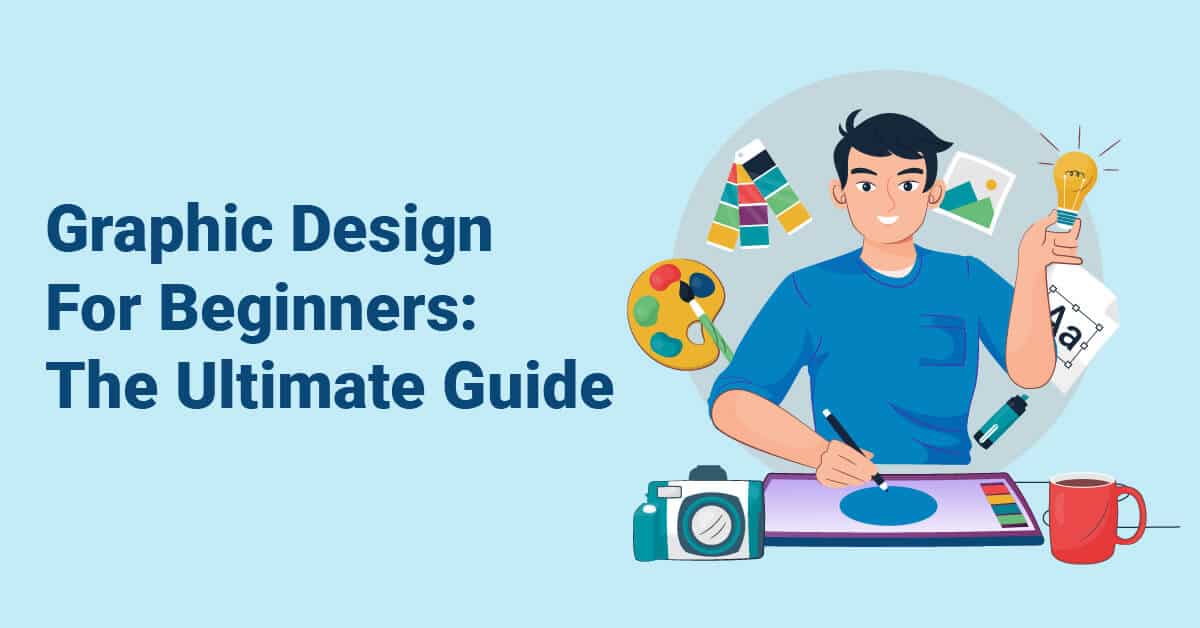
This Article Contains Everything You Need To Know To Get Started In The World Of Graphic Design
How do you get started in the world of graphic design?
As more and more businesses move online and the demand for it grows – Graphic Design is becoming a more valuable and sought after skill.
If you are looking for a career change, there has never been a better time to learn Graphic Design.
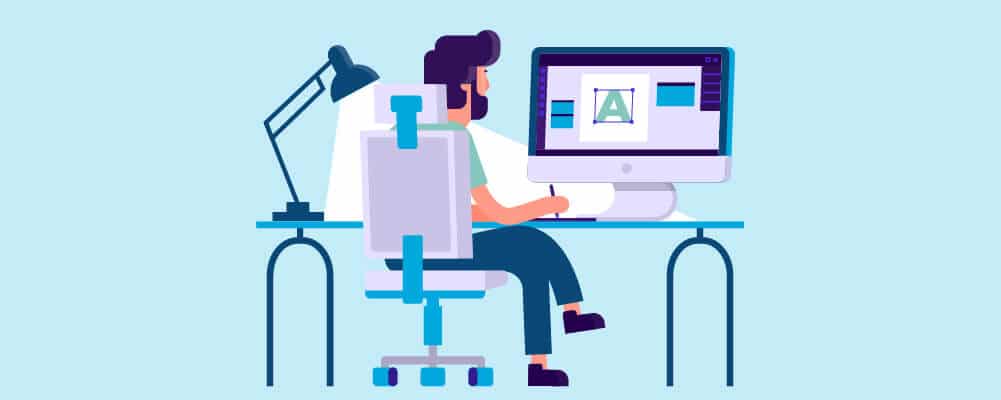
Like all complex and valuable skills, Graphic Design is not something you can pick up overnight. It takes time to learn all the smaller skills that make up what we call Graphic Design.
However, following a plan or guide can make the whole process quicker and less overwhelming.
All the time that you spend on learning these skills will pay off tenfold in the future. These skills are useful in the world of Graphic Design and also in many other industries.
You can also use them to help your own side businesses or projects in your spare time.
There are many different ways to approach learning Graphic Design, but there are basic skills that everyone will need to learn.
You must find and hold onto your passion for Graphic Design, you will need to find Graphic Design artists that inspire you, and you need to set aside time to practice your new skills.
In this article, we are going to give you a step-by-step guide to getting started with Graphic Design.
Table of contents
Learning Graphic Design: Easy First Steps For Beginners

When you are learning something new, it can be hard to know where to start. This is why we have put together this guide to help you get started with Graphic Design.
We are going to start by asking you to think about why you want to start learning Graphic Design, then to look at the people who inspire you, and then later to start working on a small project.
We also have a range of other resources to help you on your graphic design journey. To get started, try working through the following 10 steps.
1. Find Motivation
There is one way to learn a new skill and that is to build a habit of practicing it.
We are not going to get involved in the conversation about how long it takes to perfect a skill – we think that everyone is unique. What we will discuss today is something that we all need to keep us pushing through the process – motivation.
To successfully develop a skill you need to have a reason (or a “why”) to do it. Maybe you want to be able to get a job for a Graphic Design company. Maybe you want to learn to express your creativity in a new way.
Maybe you want to create displays for your stall at an exhibit. Maybe you need some Graphic Design work done for your company because you can’t afford to bring in someone new.
This “why” is what gives you the motivation to carry on learning the skill on the good days and the bad days. It is what helps you to pick up a new article on Graphic Design after you have spent a full day at work.
Take a moment to think about why you want to learn this new skill. The more specific you can be, the better.
2. Get Passionate About Graphic Design
The next step to learning a new skill is to fall in love with the process.
Have you ever heard of a successful author who doesn’t love reading books? Have you ever heard of a gold medal-winning swimmer that hates getting into the pool?
You will find learning Graphic Design and constantly improving your skills gets a lot easier when you love the process. The good news is that you can learn to love something new.
Here are three quick things that you can do today that will help you to fall more in love with graphic design:
- Think about how it can benefit you in both the short and long term. Our brains are more likely to enjoy something they think will improve our lives.
- Listen to other people talk about why they love Graphic Design. Listening to other people talk about their passions is infectious. They can change the way we look at the small things – like the power of font choice, or how colors affect our moods.
- Learn more about the history of Graphic Design and discover the stories of some of the world’s best graphic designers.
Once you have fallen in love with the process, you won’t be able to stop yourself from developing the skills you need.
3. Learn The Principles Of Design
Now, it’s time to get a little more practical. It’s time to sit down and learn the theory of the craft.
When it comes to creative skills, lots of people say – you either have it, or you don’t. The reassuring truth is that very few people are born with great creative skills, and most people who have had any kind of creative success have worked very hard to achieve it.
Take Stephen King, for example, he is one of the most commercially successful writers of all time, but he will be the first to admit that he got where he was through a lot of hard work, practice, and learning from those who came before him.
Talent is all well and good, but it won’t become something truly special until it is combined with practice.
There are a few basic principles that every graphic designer must learn. You can find guides to these basic principles on the Internet or you might want to take a course with an experienced graphic designer.
These basic principles are rules that most graphic designers follow. Sometimes it is okay to break the rules, but you need to understand what they are and why they exist before you do that.
4. Get Started With Graphic Design Software
Once you have learned the basic principles of Graphic Design, it is time to start getting to grips with the Graphic Design software that is out there.
There is a lot of debate about which type of software is the best or most suited for beginners. We recommend returning to your “why” – if you are learning Graphic Design to move into a new role or to create something specific – then look at the software that is already being used by the experts in these sectors.
The most popular software are both Adobe programs, with Illustrator for vector graphics, and Photoshop for raster graphics. If you don’t know where to start then consider one of them.
The good news for you is that we no longer live in a time where you have to go to a physical class to learn how to use these tools.
While that is still an option for you, there are an endless online tutorials and resources available at the push of a button – made by both experts and amateurs.
Whatever tools you choose or path you take to develop your skills and knowledge, a good practice would be to start by using these tools to copy already existing pieces of Graphic Design as you practice. All the Old Master painters learned to paint by copying others.
5. Find Design Resources
As we mentioned in the section above, there is a staggering amount of free and premium online resources out there. If you do not want to go to school to study Graphic Design, then there are many high-quality options available.
You could take the time to learn Graphic Design through trial and error – but you will have a much better time if you take classes, read notes from the experts, and follow some of the guides available online.
Doing this will also make the process a lot quicker for you.
No one wakes up one day knowing exactly how to do Graphic Design – they have to learn from other people and the online resources available Places like Skillshare, YouTube, and Domestika offer a great opportunity to do this.
You will also find that lots of colleges and art schools offer the opportunity to enroll in their online courses. You might even be able to walk away with a qualification in Graphic Design at the end of the course.
You will be able to find both broader and more specialized courses online.
6. Study Design Resources
Now that you have collected all the study resources that you need, it’s time to sit down and actually do the hard work.
Depending on your schedule, you may find that doing a little bit every day works well for you. However, some people find that doing a couple of hours at a time on their day offs works better for them. You know yourself best – so create a schedule that works for you.
While you are studying, you will want to make sure that you are taking the time to put what you learn into action.
Many people get so caught up in the learning and planning process that they never get around to making anything with these new skills they have learned.
Try to find a balance of learning and action that works for you. Some people need to spend 3 hours learning for every hour they spend doing. For others, it might look more like one hour spent learning for every hour working.
No matter your preferred methods, there are plenty of options out there to study. If you find one person’s teaching methods not working for you, then look for someone new. There are plenty of options out there.
7. Look For Inspiration

No matter what creative skill you are trying to learn, it is important that you consume the type of media that you are looking to make. The act of consuming the media will teach a lot more than you expect it to.
Writers learn how to tell better stories by reading books. Film makers learn shot composition by watching both good and bad films.
If you want to design exhibition booths then go round an event and make note of the ones you loved, the ones you hated, and why you think they made you feel like that.
If you want to do graphic design for video games then you need to make sure you are playing games you love, games that you don’t think look good, and games that you wouldn’t normally look up.
Stepping outside of your comfort zone can expose you to new ideas that affect your creative process. For example, Monet loved Japanese paintings and it was these painters that taught him how to paint flowers.
It was by studying something he normally wouldn’t, that he taught himself an unexpectedly useful skill.
It is also worth noting that you can learn as much from looking at a piece of Graphic Design that you don’t like, as much as looking at ones that you love.
8. Start A Project
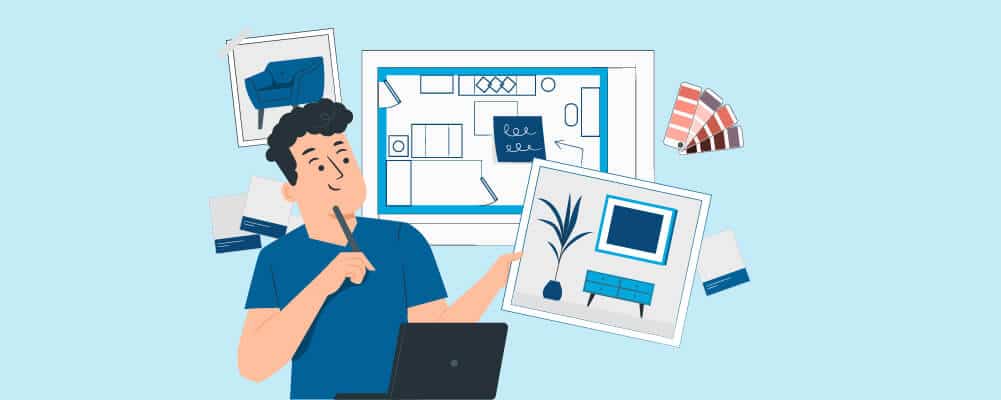
After you have done a certain amount of research, practice, and learning, it is time to start your own project. Getting stuck into a new project will teach you the things you cannot learn in a textbook, these are things you need to discover yourself.
One of the courses you are studying may include a project or you may have a project of your own in mind.
Sit down and plan out this project. Set aside time each week to do the work. And set yourself a deadline. The most important thing you can do is finish this project.
New York Times Best-Selling Author John Green says that the best way to get better at something creative is by finishing all the projects you start.
Once you have finished one project, find a new one, and keep this going. When you really love a creative process you will find that you are most happy and content when you are creating.
The more projects you finish, the more you will learn about Graphic design and the skills it requires.
9. Differentiate Talent From Practice
We mentioned earlier that it is very rare for someone to be born good at a creative skill like Graphic Design, writing, or giving presentations.
The vast majority of the people who you know who are good at the arts have achieved that through a combination of talent and hard work. Some people have gotten there on practice alone.
If you don’t instantly pick up a new skill, instantly learn how to use a new type of software, or your first project doesn’t turn out how you want it to – don’t get too disheartened. Each hour spent practicing and each mistake is only taking you closer to where you want to be.
This quote from Jacob Riis says it perfectly,
“Look at a stonecutter hammering away at his rock, perhaps a hundred times without as much as a crack showing in it. Yet at the hundred-and-first blow it will split in two, and I know it was not the last blow that did it, but all that had gone before.”
When we look at others, we see where they are now, not everything that they have done and been through to get to where they are now. It is easy to forget that the others started at the beginning too.
10. Be Consistent And Patient
Finally, you need to make sure that you are being consistent with your practice and making sure that you are constantly trying to get better at your craft or learn something new.
If you keep doing this you will find that you end up where you want to be, or that you even exceed your expectations.
The sooner you start, the sooner you will get to where you want to be. So, why not start today, after you finish reading this article?
Graphic Design Tips For Beginners
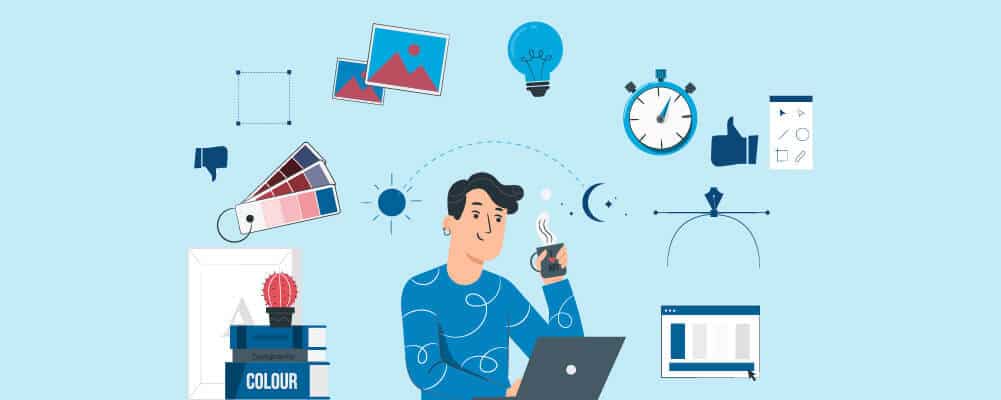
Before we leave you, we want to share 14 little tips and tweaks that will help you to get better at Graphic Design.
These tips have been shared with us by the many graphic designers we know. Things that they wish they knew when they first started learning the skill.
The tips range from simple things like not overcomplicating your design, to making use of the psychology of color, and much more.
We recommend that you read through these tips before you dive into your first Graphic Design project. We hope you find them helpful.
Keep It Simple
How can you tell you are looking at a design made by a beginner? There’s too much going on.
Beginners will benefit from listening to this tip, but so will many more experienced designers. One of the most basic rules of design work is that “less is more”.
This rule is going to help you as a beginner because you are going to have an easier time putting together designs and there will be fewer things that could go wrong.
Sometimes beginners can be tempted to put a lot of different elements into their early designs partly because they want to use everything they have just learned.
Use simple shapes, colors, and fonts – it will make you look like a more experienced designer.
Keep The Typography Under Control
Another way to tell that a design has been done by a beginner is that none of the fonts look good together. Or that there are too many fonts used in the design.
There is nothing wrong with using unique and exciting fonts – but it is a general rule of thumb that those fonts should be used as titles and you should use a more traditional font in the body of the text.
Try to keep your use of fonts consistent across all work you do for one client. You can find out more about fonts here.
Be sure to learn about kerning, leading and tracking, as well as the use of bold, italicized, and underlined fonts. Understand the difference between a font and a typeface.
Control the Color Pallet
The next thing you need to think about is putting together a consistent color pallet for your project.
You want to make sure that this color pallet creates the right tone for your project. You want it to complement the brand the project is based on and the fonts that you have picked out.
Some designs get away with using clashing colors, but only when they are appropriate for the brand or theme of the project. For example, if you are putting together displays for an exhibition, you may want to use bright colors that people can spot across a large room. But consider readability; for example, bright blue text on a bright red background will be practically invisible.
Consider The Visual Hierarchy
Visual hierarchy sounds a lot more complicated than it is. Visual hierarchy is the name for giving the more important parts of your design the most area on the page.
For example, if you are advertising an upcoming event, you want to make sure that the title of the event, as well as its time and location, are clearly visible on the poster. You can make the advertising copy for the event a little smaller.
Leverage the Use of Templates
If you are creating content for Facebook and Instagram, then you are going to need to make sure that your designs are as consistent as possible.
If you need to turn over a lot of content, then you will find that buying or creating a social media template will make the job a lot easier for you, and will ensure that your work fits within the many different requirements and specifications of the different media platforms.
If you work in the trade show industry, you will find that graphic templates exist for almost every display type and size, ready for your use.
You can use these templates as a base, and build each design on top of them. Without having to spend too much time making sure the dimensions are correct and that the details match from post-to-post.
When putting together a template, you will find it helpful to put together a design board for the project or brand that includes fonts, color scheme, and approved illustrations.
Always Use White Space
It is not uncommon for new designers to try and fill the entire page. They feel like blank space is wasted space. When, in many cases, the opposite is true.
When used correctly, negative space can do just as much as a filled area.
Many people find looking at a poster, display, or logo that is too crowded overwhelming. By leaving empty space in your design you are allowing the viewer space to take in the information without being overstimulated to the point that their eyes glaze over and they ignore the message.
This goes back to the basic design rule – less is more.
Use Cohesive Design Elements
We have talked about making sure your colors don’t clash with each other. We have also talked about the importance of using fonts that complement each other.
Now, let’s take it a step further and talk about using consistent and cohesive design elements.
If you have decided to use square text boxes at the top of your design, you should make sure that you use them throughout the design – clashing shapes can make the piece look amateurish and too busy.
The same goes for illustrations – if you use line drawings in one part of the project, you will want to make sure that you use them throughout the whole project.
Make Use Of Spacing
Human beings like looking at displays that are neat and balanced – just look at the way we design buildings.
When you are putting together a design, you are going to want to make use of the spacing to make sure everything looks clean, balanced, and even.
People will find your design frustrating if you are using inconsistent line space across the project. They also prefer design elements to be evenly spaced across the piece. Visual symmetry is important and should not be overlooked.
If you are going to put something in the center of your design, make sure it is in the dead center. If you’re going to tilt something or make it off center, you want to do it enough that it doesn’t look like a mistake.
Rule of Thirds as well.
Optimize Readability
Choice of font, use of spacing, and making the most of the negative space are all important because it makes it easier for your audience to read your design.
You want people to be able to easily understand what you are trying to do with your design – whether that’s advertising your company, trying to teach them something new, or telling them about an event that is happening soon.
If they cannot easily tell what you are trying to say with your design then you have failed. Keep things as easy to read as possible.
Consider The Psychology Of Colors

Earlier, we talked about the importance of getting synergy with your color story. Now, we want you to think about what you are trying to say with that color story.
A lot of research has been done to record how different colors make people feel – it is referred to as the psychology of colors.
For example, many people relate the color white to purity and sophistication. Whereas, the color black is typically related to authority and elegance.
So, if you were doing work for a Poker company, you might want to use black in your color pallet. But if you were advertising a self-care workbook, white would be a good color to work with. The main message here is, colors matter. Consider them carefully.
Know The Dimensions You Need Beforehand
There is nothing worse than spending weeks on a design, only to find out that you have made it to the wrong dimension.
When it gets displayed, printed out, or uploaded it will inevitably look bad. And that will make you look like you don’t know what you are doing.
The dimensions of your final product must feed into how you put your design together. Therefore, you shouldn’t be able to start your work on a project until you have the dimensions locked down.
We’ve mentioned using templates previously; as our graphic design team checks customer designs, the first step is ensuring they used the correct graphic template – this ensures that the dimensions are correct!
Know What Type Of File You Need When Downloading
Something else you need to be aware of before you start a project is what type of file you will need to convert your final project into.
Will it be a JPEG, will it be a PDF or something else entirely? The final form of the project you should feed into how you create your designs.
Each type of file will compress and convert differently – many of them also print out differently too.
PNG and JPG are both web-based images. If the image can stand to be more compressed/smaller file size, go with JPG. If you want the image to be lossless or have a transparent background, use a PNG file.
Stay Organized
If you are not an organized person, this is a skill you will need to develop quickly if you want to be successful in the world of Graphic Design.
Even if you are only doing work for yourself, you will notice that a little organization will make your life a lot easier.
To get started, you need to make sure that you have a good filing system on your computer. You will want to clearly label every element that is used in the creation of your piece.
You will also want to make sure that all your drafts are clearly labeled too.
Don’t forget to regularly back up your files onto the cloud or an external hard drive.
Trust The Process
Finally, we want to remind you not to be too hard on yourself during your creative process.
At the beginning of a project, things may seem like they are taking too long or that they are not going well. When you start to feel frustrated, we recommend that you take a break, relax, and trust the process.
Don’t be tempted to try and take a shortcut, this will only make things more difficult for you in the long run.
Remember, the design process has come together through trial and error over a long period of time – the process exists in its current form for a reason.
Trust it and everything will come together in the end.
Summary
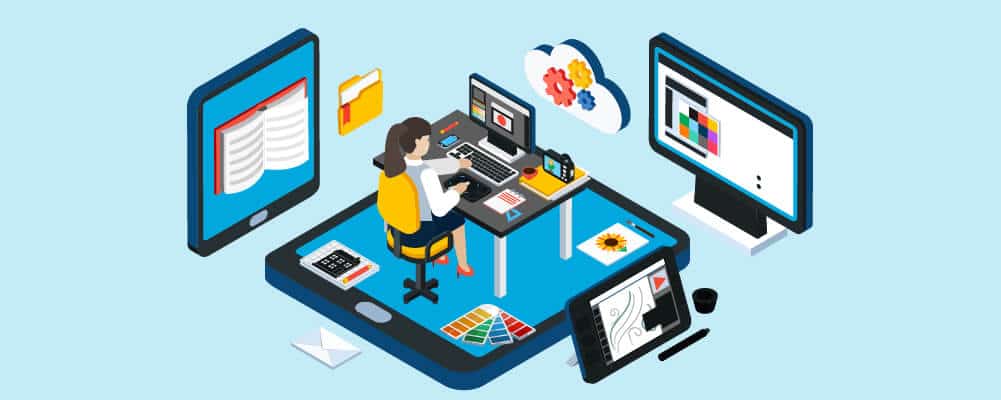
Learning Graphic Design could make a huge difference in your life. You could use it to change your career, you could use these new skills to make you more valuable to your current company, and these skills could upgrade your side hustles.
There has never been a better time to learn Graphic Design. After the pandemic, many businesses have relied more on online platforms and resources than ever before.
And there has never been more demand for Graphic Design skills. While learning Graphic Design can be a long process, there are many things you can do to make sure that you are working smarter, not harder.
When you are learning this new skill, you should take the time to look at how the people who have previously learned the skill did. Take their advice, learn from their mistakes, and most importantly, have fun while you are learning. American Image Displays necessarily maintains an experienced team of graphic designers; if you every have any questions about design, just reach out – our experts are always willing to assist.
